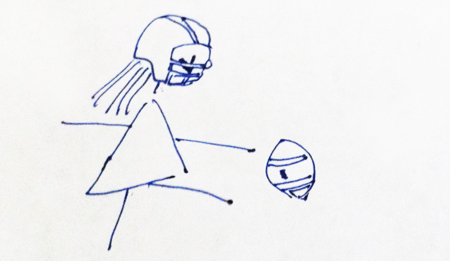Super Bowl XLVI.
Chances are, a last minute field goal will decide the game.
Of the 45 past Super Bowls, six (13%) have been decided by three points or less.
Four of those games have come down to a field goal in the last minute of the game. A lot of pressure is put on the kickers in these situations, and their historical legacies are cemented by whether they make it (O’Brien in Super Bowl V, Vinatieri in Super Bowls XXXVI and XXXVIII) or not (Norwood in Super Bowl XXV – the Wide Right Game).
Each of the four Super Bowls that New England has made it to during the Belichick / Brady era have been decided by three points, so if Sunday goes according to recent history, kickers may play a center stage role in this Super Bowl as well.

In this scenario, some teams employ the tactic of trying to ice the kicker, meaning –
Icing the Kicker
: a tactic employed by defending teams to disrupt the process of kicking a field goal just prior to the snap.
So to get to the question: Does icing the kicker work?
Inconclusive, but looking like probably not.
- A 2010 story in the Wall Street Journal mentioned that for field goals (since 2000) in the final two minutes of the game or overtime, NFL kickers made 77.3% of field goals when no timeout was called vs. 79.7% when a timeout was called.
- An ESPN article mentions that icing the kicker in the last 10 seconds of the game actually increases the chance that the kick will be successful. They don’t mention the sample size, however.
- A University of San Diego study indicated that for field goals (when there was point differential of three points or less in the last minute) between 2002 and 2007, iced kickers were successful 66.4% of the time vs. 80.4% when they weren’t iced.
- On the other hand, Stats Inc. found for that pressure kicks (point differential of three points or less in the last two minutes) between 1991 and 2005, iced kickers were successful 72% of the time vs. 71.7% when they weren’t iced.
Of the four studies mentioned, two show no significant difference, one shows that icing the kicker works, and the other one shows that icing the kicker actually increases the kicker’s chances of success. Results vary based on the timeframe, how a pressure kick was defined (last two minutes, three minutes, 10 seconds, etc…) and sample size. No matter how you look at it though, the case for icing the kicker looks very inconclusive.
So why do coaches still try to ice the kicker if it doesn’t actually seem to work based on past data?
Confirmation bias might be at play. Past experiences, ascribing missed kicks to a timeout call when those misses should be expected based on probability.
Statistical analysis in sports has been fitfully embraced, with many coaches and managers preferring to rely on visuals and past experience. Media and the general public reinforce this, praising coaches for icing the kicker to win a game, questioning others on their decision not to ice a kicker.
Coaches like to think they can influence the game. They are used to the belief their playcalling and decisions having a significant impact on the results of any given play. When it comes down to a high importance game winning or game tying field goal attempt, they won’t want to believe they can’t affect the result. Even if evidence solidly proved that icing the kicker was ineffective, coaches will probably still call timeouts so that they aren’t left standing powerlessly on the sidelines. Because in the end, we all like to think that we have some control over things.
Will we see someone ice Gostkowski or Tynes at the end of Super Bowl XLVI? With the Patriots as only 2 1/2 point favorites over the Giants, there’s a pretty reasonable chance the game will be decided by a field goal at the end!

